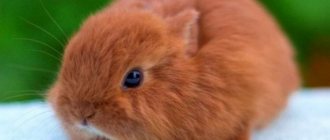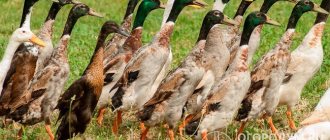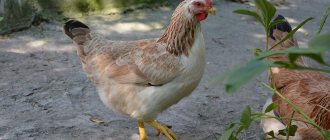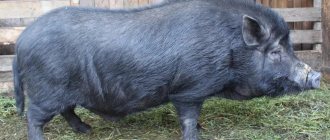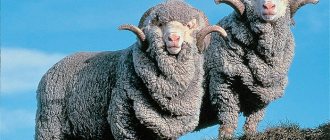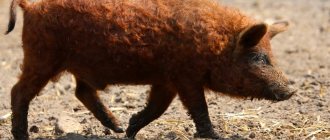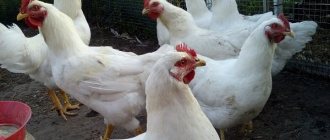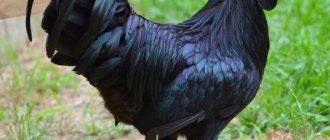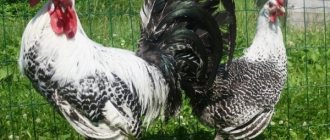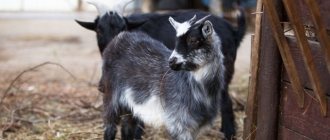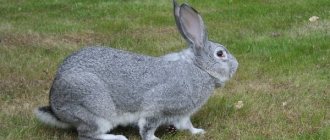Sheep were domesticated by humans in ancient times. They are kept for their wool and meat. The first domestic sheep appeared about 8 thousand years ago, in what is now Turkey. Gradually, sheep farming began to be practiced throughout the world. Nowadays huge numbers of sheep can be found in China, Australia, India, etc.
Sheep's wool is used much more often than the wool of other animals. Lamb is the favorite meat of many peoples. Cheese cheese and cooking fat are made from sheep's milk. The sheep was the world's first cloned mammal.
Nowadays, many breeds of sheep have been developed, which differ significantly from each other. The largest sheep in the world weigh more than 180 kg. Constant selective selection is carried out, which helps to improve certain characteristics of animals.
Romanovskaya, 50-100 kg
In the 18th century, in the Yaroslavl province, the Romanov sheep . She was one of the most outstanding in terms of fur coat qualities and received this name because... initially spread in the Romanovo-Borisoglebsky district.
The queens of this breed are small, weighing up to 55 kg, but some individuals grow up to 90 kg, while the rams are much heavier - from 65 to 75 kg, sometimes they weigh 100 kg. They are kept for the lightest, most elegant and durable sheepskins.
The skin of lambs 6-8 months old is especially valued. Babies of this breed have a black coat, but from the second to fourth week it becomes lighter, and by five months it becomes depigmented.
But, despite the fact that they are bred for sheepskin, they are also valued as sources of meat, because... Already at 100 days, lambs can weigh up to 22 kg, and at 9 months - 40 kg.
Kuibyshevskaya, 70-105 kg
This breed of sheep received its name due to the place where it was bred - in the Kuibyshev region in the mid-30s of the twentieth century. During the war, breeding work had to be interrupted, but in 1948 a new domestic breed was finally formed.
Sheep of the Kuibyshev breed are distinguished by thick, long and dense wool with large white curls. But they are also kept for their meat. At 4 months, rams already weigh up to 30 kg, by 12 months they gain up to 50 kg, and an adult animal can weigh up to 120 kg.
The meat of sheep of this breed is considered to be of high quality; it does not have a dense inner layer of fat, but only a delicate fat layer. It is called marble, and it is highly valued because... It is distinguished by tenderness and juiciness. But such meat only comes from free-grazing animals.
Second level of rating
The second place among representatives of this group of animals living in the wild, in terms of size, is given to the maned ram. Representatives of this breed are found exclusively in North African lands. They reach 1.2 m in height, and can grow up to 1.7 m in length. Body weight can reach 150 kg. In addition, only males can be so large.
Females are half the size and weigh 3-4 times less. The coat color of the maned ram is beige or reddish-brown, there are light stripes in the chin, belly and along the inner surface of the limbs. The size of the horns reaches about 80 cm, they do not look as impressive in comparison with the argali.
Important! Maned rams are characterized by an amazing ability to camouflage. They can remain completely motionless for many hours if they sense danger.
North Caucasian, 60-120 kg
This is a meat-haired breed that was bred in 1944-1960. Sheep of the North Caucasian breed are distinguished by their large growth. They are white in color, but there may be small spots on the ears, legs and nose of a darker color.
The ewes of this breed weigh from 55 to 58 kg, while the weight of rams is from 90 to 100 kg, with a maximum weight of 150 kg. Most often this breed can be found in the North Caucasus, Armenia and Ukraine. Another advantage is its high fertility. 100 queens can produce about 140 lambs.
Giant Vagin
The largest ram statue is in Australia. The giant ram named Vagin, named after the city where the monument is erected, is 7 m high and 15 m long. It symbolizes the importance of the wool spinning industry, which became the key to the material prosperity of the town, founded in 1889.
But nature sometimes brings surprises. For example, the largest sheep in the world today is a Suffolk ram, 1.10 m tall and weighing 248 kg. He lives on a farm in the US state of Oregon.
Gorkovskaya, 80-130 kg
A domestic breed that was bred on collective farms in the Gorky region of the former USSR in the 1936-1950s. These are quite large animals: rams can weigh from 90 to 130 kg, and queens - from 60 to 90 kg. They have long white fur, but the head, ears and tail are dark.
The Gorky breed is considered early maturing, quickly pays for all feed costs, and is quite prolific. The disadvantages include a small amount of wool and uneven fleece.
Reproduction
Mating in sheep is almost always free; shepherds do not monitor the signs of heat in the queens, but simply graze both sheep and rams together in the herd. This allows you to have offspring from sheep almost all year round.
The Gissar sheep bears offspring for 145 days. During this period, it is advisable to transfer her to the most fruitful pasture before the appearance of offspring.
Lambing almost always occurs quickly and without outside intervention .
Born lambs quickly gain weight. With properly organized grazing, the availability of succulent nutritious grasses and additional feed, lambs can gain up to 600 grams in weight per day. As soon as they begin to grow stronger, they are either driven to poorer pastures or sold for meat.
The most expensive and best horses in the world: breed characteristics and price
Volgogradskaya, 65-125 kg
The breed appeared in the Volgograd region, on the Romashkovsky state farm, in 1932-1978 of the twentieth century. As a result of long work, they were able to breed animals with thick white wool, which grows up to 8-10.5 cm. Up to 15 kg of wool is collected from a ram, and up to 6 kg from the uterus.
It is also impossible not to note the meat qualities of the Volgograd breed . Queens weigh up to 66 kg, and rams weigh from 110 to 125 kg. This breed is bred in the Volga region, the Urals, and central Russia.
The number of this livestock is constantly growing, because it has many advantages: it matures early, is fertile, produces a lot of wool and meat, quickly adapts to the conditions of detention, can withstand any weather conditions, and has excellent immunity.
Dorper, 140 kg
The breed appeared in 1930 in the south of America. At that time, breeders were working on breeding animals that would not be afraid of unbearable heat. The result was the Doper breed , whose representatives can live without water for 2-3 days and feel normal without a balanced diet. And at the same time it has good productive qualities.
This is a meat breed, which can be recognized by its white body color and black head and neck. In the summer, animals shed, there are almost no areas with fur left, but this is not a disadvantage, but an advantage, because these sheep don't need to be sheared.
Sheep of the Doper breed are hardy, their population numbers are rapidly increasing (lambing is 2 times a year, often more than 1 lamb), they are not picky about food, and have strong immunity. The weight of an adult female is from 60 to 70 kg, and that of a ram is from 90 to 140 kg. The meat has excellent taste and smells pleasant.
What breeds are profitable to keep in Russia?
For Russian sheep breeders, the main criterion when choosing animals is the presence of stability and physical strength.
The animal must be hardy to certain climatic conditions (northern frost, southern and steppe winds). Naturally, an important requirement is to receive direct profit. When livestock requires large expenses in comparison with the income received, such a business will incur losses.
It is possible to produce offspring from high-quality ewes twice a year, with 2-3 young in one litter. Lambs of meat breeds are characterized by rapid maturation; at 4-8 months of age they are considered ready for slaughter, as they reach the required weight. Females can be fertilized as early as 6 months of age. Thanks to this quality, you can get a large flock in a short time to start a trade turnover.
When the purpose of keeping sheep is not only to obtain meat, but also to obtain wool products, it is worth carefully considering how high-quality the guard hair is and what its volume is. Professionals advise choosing places to sell wool outside the borders of the countries of the former Soviet Union or processing fleece into yarn for use in light industry.
To obtain maximum profit, it is better to breed sheep of the Romanov, Gissar, Kuibyshev or Caucasian breeds.
Edelbay, 160 kg
The breed appeared about 200 years ago; Kazakh shepherds worked on its creation. They sought to develop a breed of sheep that could adapt to a nomadic lifestyle: it was hardy and could withstand difficult living conditions.
the Edelbay breed appeared , which is not afraid of either extreme heat or cold; they can get by by eating the sparse vegetation of the steppe and at the same time rapidly gain weight. They belong to fat-tailed sheep, i.e. with fatty deposits near the sacrum.
On average, a ram weighs 110 kg, and a sheep - 70 kg, but some specimens gain up to 160 kg. They provide not only meat, but also wool, lard, and fatty milk. Disadvantages include poor fertility and poor coat quality, as well as sensitive hooves.
